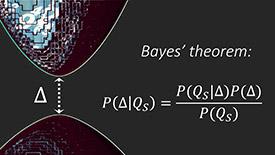

10/25/2021

© 2021 Takafumi Sato
A team led by AIMR has developed a new technique for interpreting surface electronic-states characterizations by modeling angle-resolved photoemission spectroscopy (ARPES) data using a Bayesian approach1. The team demonstrates this technique by confirming the size and by elucidating the microscopic origins of the TlBi(S,Se)2 Dirac gap.
In condensed-matter physics, the many-body problem often complicates experimental measurements.
For example, the surface electronic states mapped by techniques such as ARPES are a convolution of the bare-band dispersions (Ε, single-electron dispersions) with the electron self-energies (Σ, multiple-electron correlations). This convolution makes graphene band gaps and dispersion kinks of high-temperature superconductors difficult to explain by ARPES measurements alone.
That is, unless each of the two components can be statistically extracted using known quantities.
Here, the team demonstrates an approach to investigating surface states by applying Bayesian modeling to the ARPES data acquired on a TlBi(S,Se)2 surface—a material whose Dirac cone characterizations have been controversial due to the many-body problem.
“The Bayesian approach is very good at inferring the probability of any event, provided that quantities relevant to the event are either known, or can be modeled from real data,” says Takafumi Sato, the principal investigator.
To this end, the team formulates a semiparametric Bayesian analysis expressing all relevant spectral quantities (QS, which include Ε and Σ) to model an ARPES map of TlBi(S,Se)2. The modeling provides estimates for all QS, enabling the team to ask physical questions such as whether the TlBi(S,Se)2 Dirac cones are gapped.
Using Bayes’ theorem (see Figure), the team calculated that the probability P(Δ|QS) of TlBi(S,Se)2 having a gap of size Δ = 0 is negligible, concluding that the bare-band TlBi(S,Se)2 Dirac cones must be gapped.
“With this technique, we were not only able to calculate the Dirac gap size with high precision, but we were also able to narrow down the microscopic origins of the gap,” says Sato. “This would not have been possible without the ability to deconvolve the many-body problem.”
Future directions will apply this technique to other quantum materials to demonstrate its applicability.
(Author: Patrick Han)
This research highlight has been approved by the authors of the original article and all information and data contained within has been provided by said authors.